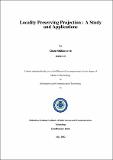Please use this identifier to cite or link to this item:
http://drsr.daiict.ac.in//handle/123456789/410Full metadata record
| DC Field | Value | Language |
|---|---|---|
| dc.contributor.advisor | Mitra, Suman K | |
| dc.contributor.author | Shikkenawis, Gitam | |
| dc.date.accessioned | 2017-06-10T14:40:09Z | |
| dc.date.available | 2017-06-10T14:40:09Z | |
| dc.date.issued | 2012 | |
| dc.identifier.citation | Shikkenawis, Gitam (2012). Locality preserving projection : a study and applications. Dhirubhai Ambani Institute of Information and Communication Technology, xi, 52 p. (Acc.No: T00373) | |
| dc.identifier.uri | http://drsr.daiict.ac.in/handle/123456789/410 | |
| dc.description.abstract | Locality Preserving Projection (LPP) is a recently proposed approach for dimensionality reduction that preserves the neighbourhood information and obtains a subspace that best detects the essential data manifold structure. Currently it is widely used for finding the intrinsic dimensionality of the data which is usually of high dimension. This characteristic of LPP has made it popular among other available dimensionality reduction approaches such as Principal Component Analysis (PCA). A study on LPP reveals that it tries to preserve the information about nearest neighbours of data points, thus may lead to misclassification in the overlapping regions of two or more classes while performing data analysis. It has also been observed that the dimension reducibility capacity of conventional LPP is much less than that of PCA. A new proposal called Extended LPP (ELPP) which amicably resolves two issues mentioned above is introduced. In particular, a new weighing scheme is designed that pays importance to the data points which are at a moderate distance, in addition to the nearest points. This helps to resolve the ambiguity occurring at the overlapping regions as well as increase the reducibility capacity. LPP is used for a variety of applications for reducing the dimensions one of which is Face Recognition. Face Recognition is one of the most widely used biometric technology for person identification. Face images are represented as highdimensional pixel arrays and due to high correlation between the neighbouring pixel values; they often belong to an intrinsically low dimensional manifold. The distribution of data in a high dimensional space is non-uniform and is generally concentrated around some kind of low dimensional structures. Hence, one of the ways of performing Face Recognition is by reducing the dimensionality of the data and finding the subspace of the manifold in which face images reside. Both LPP and ELPP are used for Face and Expression Recognition tasks. As the aim is to separate the clusters in the embedded space, class membership information may add more discriminating power. With this in mind, the proposal is further extended to the supervised version of LPP (SLPP) that uses the known class labels of data points to enhance the discriminating power along with inheriting the properties of ELPP | |
| dc.publisher | Dhirubhai Ambani Institute of Information and Communication Technology | |
| dc.subject | Image processing | |
| dc.subject | Digital techniques | |
| dc.subject | Biometric identification | |
| dc.subject | Computer vision | |
| dc.subject | Pattern recognition | |
| dc.subject | Human face recognition | |
| dc.subject | Dimensionality reduction | |
| dc.subject | Dimension theory | |
| dc.subject | Topology | |
| dc.classification.ddc | 621.367 SHI | |
| dc.title | Locality preserving projection: a study and applications | |
| dc.type | Dissertation | |
| dc.degree | M. Tech | |
| dc.student.id | 201011049 | |
| dc.accession.number | T00373 | |
| Appears in Collections: | M Tech Dissertations | |
Files in This Item:
| File | Description | Size | Format | |
|---|---|---|---|---|
| 201011049.pdf Restricted Access | 4.05 MB | Adobe PDF |  View/Open Request a copy |
Items in DSpace are protected by copyright, with all rights reserved, unless otherwise indicated.
